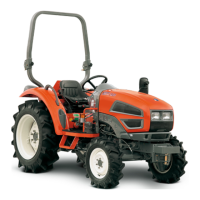
Do you have a question about the Kioti CK22 and is the answer not in the manual?
| Engine Power | 22 hp |
|---|---|
| Engine Type | 3-cylinder diesel |
| Transmission | Hydrostatic |
| Fuel Capacity | 6.6 gallons |
| Drive | 4WD |
| Hydraulic Remotes | 1 |
| 3-Point Hitch | Category I |
Essential pre-operation checks and general safety guidance for safe tractor use.
Guidelines for safe operation, avoiding hazards and ensuring proper handling.
Safe practices for driving the tractor, including speed, turning, and braking.
Procedures and safety measures for parking the tractor correctly.
Safety instructions for operating the Power Take-Off (PTO) system and related equipment.
Safe procedures for attaching and using implements with the 3-point hitch.
Safety precautions to follow during tractor maintenance and servicing.
Importance and location of safety labels on the tractor for user awareness.
Detailed technical specifications including engine, drivetrain, and hydraulic system data.
Guidelines on compatible implements and their weight limitations for safe operation.
Information on tractor traveling speeds based on gear selection and engine RPM.
Identification of external tractor components and their locations.
Overview of the tractor's instrument panel, gauges, and control switches.
Explanation of the various foot pedals and hand levers used for tractor operation.
Routine checks to perform before starting and operating the tractor.
Guidance on handling and breaking in a new tractor for optimal performance and longevity.
Procedures for starting, operating, and stopping the engine safely.
Procedures for jump-starting a tractor's battery using another vehicle.
Proper use of ROPS and seat belts for operator safety.
Managing travel speed, PTO, FWD, and differential lock.
Safe use of brake pedals and parking brake.
Adjusting seat position, controls, and optional features like cruise control.
Understanding dashboard gauges, warning lamps, and switches.
Procedures for stopping the tractor and general operational guidance.
Steps and safety precautions for attaching implements to the 3-point hitch.
How to adjust the drawbar length and check chains for proper implement alignment.
Function and adjustment of check chains for side sway control of implements.
Operation of the hydraulic control lever for the 3-point hitch lift arm.
Adjusting the limit for the implement lowering speed and position.
Use and connection of the hydraulic block outlet for external equipment.
Operation and safety for the joystick valve controlling auxiliary hydraulic functions.
How to operate the remote control valve lever for hydraulic implements.
Procedures for safely connecting and disconnecting hydraulic couplers.
Recommended tire inflation pressures for different wheel sizes and types.
How to adjust the rear wheel tread width for stability and clearance.
Information on front and rear ballast for improving traction and stability.
Instructions for opening covers and performing essential daily inspections.
Procedures for checking fluids, refueling, and lubricating grease fittings.
Steps for changing engine oil and replacing the oil filter.
Procedures for changing transmission and front axle case oil.
Adjusting brake pedals, handbrake, and fan belt tension.
Inspecting radiator hoses, HST oil lines, power steering lines, and cooling system.
Information on battery handling, charging, and replacing fuses/bulbs.
Procedures for bleeding the fuel system and replacing the fuel filter.
Checking wheel bolt torque and fuel filter condition.
Steps to prepare the tractor for extended storage to prevent damage.
Procedures for preparing the tractor to operate after a period of storage.
Common engine problems, their causes, and corrective measures.
List of optional accessories and features available for the tractor.
